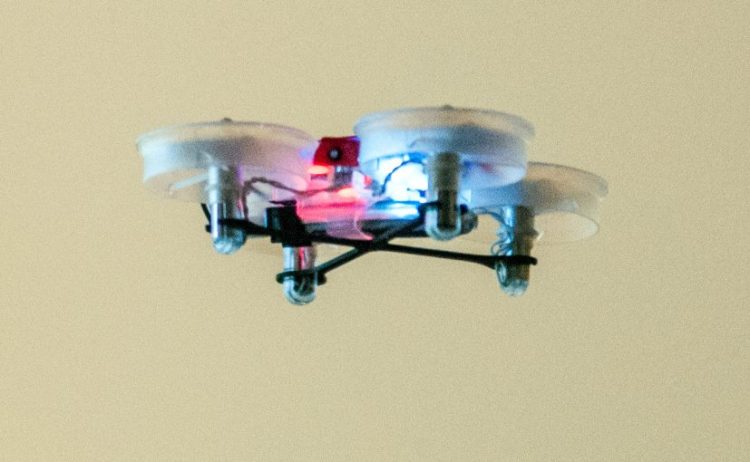AUGUSTA — With unmanned aerial vehicles playing an increasing role in aviation, University of Maine at Augusta officials say the college’s fledgling course for remote pilot operators will have practical uses in the business world.
The school offered Maine’s first university-level unmanned aerial vehicles course last October with 35 students, and another course in the spring with about 50 participants. Eleven people are enrolled for this year’s course, which prepares students to pass the Federal Aviation Administration’s test for remote pilot operators.
The seven-week drone course is funded by a $250,000 grant from the University of Maine System Research Investment Fund.
Patrick Egan, who hosts a podcast on unmanned aircraft systems and has spent several years promoting their business use, said in an email interview that educators and trainers face challenges as the industry continues to grow.

Lewiston High School student T.J. Morin, left, takes a small drone from aviation instructor Dan Leclair as fellow Lewiston High student waits with his hands on the remote control to try flying it July 28 in Randall Hall on the University of Maine at Augusta campus.
“The greatest challenge is (developing) a curriculum that is relevant to the real world,” he said. “Drones have always held promise for those that can use them as a tool to augment existing professional business models.”
In Maine, unmanned aerial vehicles are being used in real estate, precision agriculture, search and rescue, land management and construction, said Daniel Leclair, one of the UMA program’s coordinators and a colonel in the Civil Air Patrol.
To survey a 15-mile stretch of road costs about $15,000, Leclair said, but someone can do it with a drone for about one-seventh of that.
“Our students will be able to show they have a competency and concentration in unmanned aircraft systems with an aviation degree, and that’s highly desirable,” Leclair said.
To receive a bachelor of science degree in aviation with an unmanned aircraft systems concentration, students take a design, building and maintenance course, an internship and numerous flight instruction classes. Leclair said the skill set acquired is just the kind companies that use unmanned aerial vehicles are looking for – training that teaches “a clear understanding of what’s inside these things, how they work and how they fly.”
“Our students will actually learn to fly these systems, and there are no other programs in the United States doing that right now,” he said. “It’s really neat to be on the forefront of this stuff and on the leading edge.”

Lewiston High School student Noah Bisson, left, flies a small drone July 28 in Randall Hall on the University of Maine at Augusta campus. T.J. Morin, center, from Lewiston High, and Curtis Ouellette, of Edward Little High School, watch.
Nathaniel Leonard completed the seven-week course last year and has begun using UAVs in his marine consulting business, conducting beach surveys of potential beaching sites for landing aircraft in the Alaskan Arctic and doing aerial surveys of grounded vessels prior to salvage operations.
Leonard said he wants to expand that use to include “filming of vessels underway to study the interaction between the water and a vessel underway and different speeds to allow the most efficient speed and trim for reduced fuel consumption.” He also wants to conduct “aerial surveys of cracks through sea ice so vessels can transit the Arctic ice cap speedily and safely.”
Thomas Abbott, another program coordinator at UMA, said the package delivery company UPS is testing the use of drones to reduce the cost of last-mile delivery. He envisions a standard UPS truck with a hole in the roof that houses a large, multi-rotor drone that has a mesh basket underneath. From a main road between two towns, a driver can send a package or two to a farm at the end of a long dirt road.

An aerial view of the University of Maine at Augusta Convocation last September taken by a drone operated by two students of the UMA Aviation Program, Greg Jolda and Dan Leclair.
“The drone lands in the farmhouse yard, drops the packages and then catches up with the UPS vehicle in the next town, ready for another remote package delivery,” he said. “It’s autonomous flying programmed by GPS.”
Last August, the FAA released new comprehensive regulations for nonrecreational use of unmanned aerial vehicles to minimize the risk to other aircraft and people and property on the ground. The UMA courses will teach how to operate the aircraft safely while following all federal guidelines.
“They’ll learn about flight computers, motors, speed controllers, propellers and how to deal with and control cameras,” Leclair said. “We teach the basics, so once you understand how these aircraft work, you can get in there.”
UMA’s aviation program costs around $110,000, but graduates can earn six figures working for large corporations fairly soon after graduation. Abbott said students are immediately in demand upon graduation and licensure.
Jason Pafundi can be contacted at 621-5663 or at:
jpafundi@centralmaine.com
Twitter: jasonpafundiKJ
Send questions/comments to the editors.




Comments are no longer available on this story